Angkor WHAT?!
Dead early in the morning, we took a short bus ride from the hotel through the darkness. Flashlight glittered in the night along with the much more common phone lights. I had to use the phone light and almost tripped multiple times over the large uneven cobbles and the stairs. I followed the ongoing conversations occurring in at least a dozen different languages. The crowd was moving toward the man-made ponds ahead of the front (west) facade of the middle temple. We still had little, if any, light other than the artificial light that didn’t cast far. But with each passing minute, the sun inched closer and closer to the horizon.
Still in almost pitch black, I excused my way through the crowd to sit low down in front of the water line. Mistakenly, I took a step forward while about to set up a photo angle and felt the cool water seep into my shoe and the squish of the mud as I fell back onto my ass to avoid tumbling into the pond.
Minute by minute, ten, 20, 40 minutes, and the sun still hadn’t risen, the light was glowing reddish-orange over the temple, making for some beautiful photos, especially with the reflections from the water (Figures 1-4). But the clouds partly coated the sky, stopping the sun from shining with all its glory. The architectural precision used to build the entire complex meant that the sunrise on the equinoxes was directly behind the middle temple (where we were sitting).
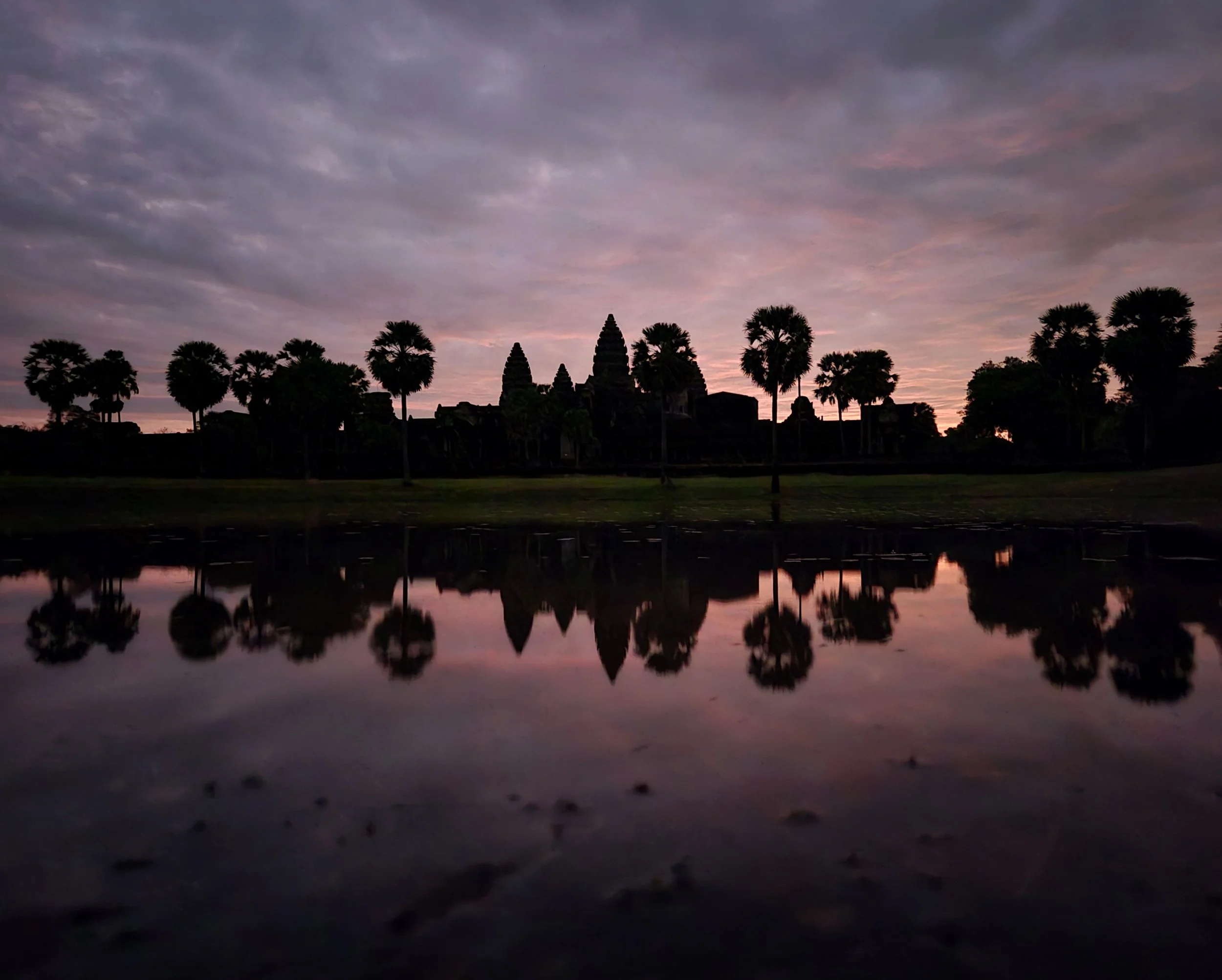
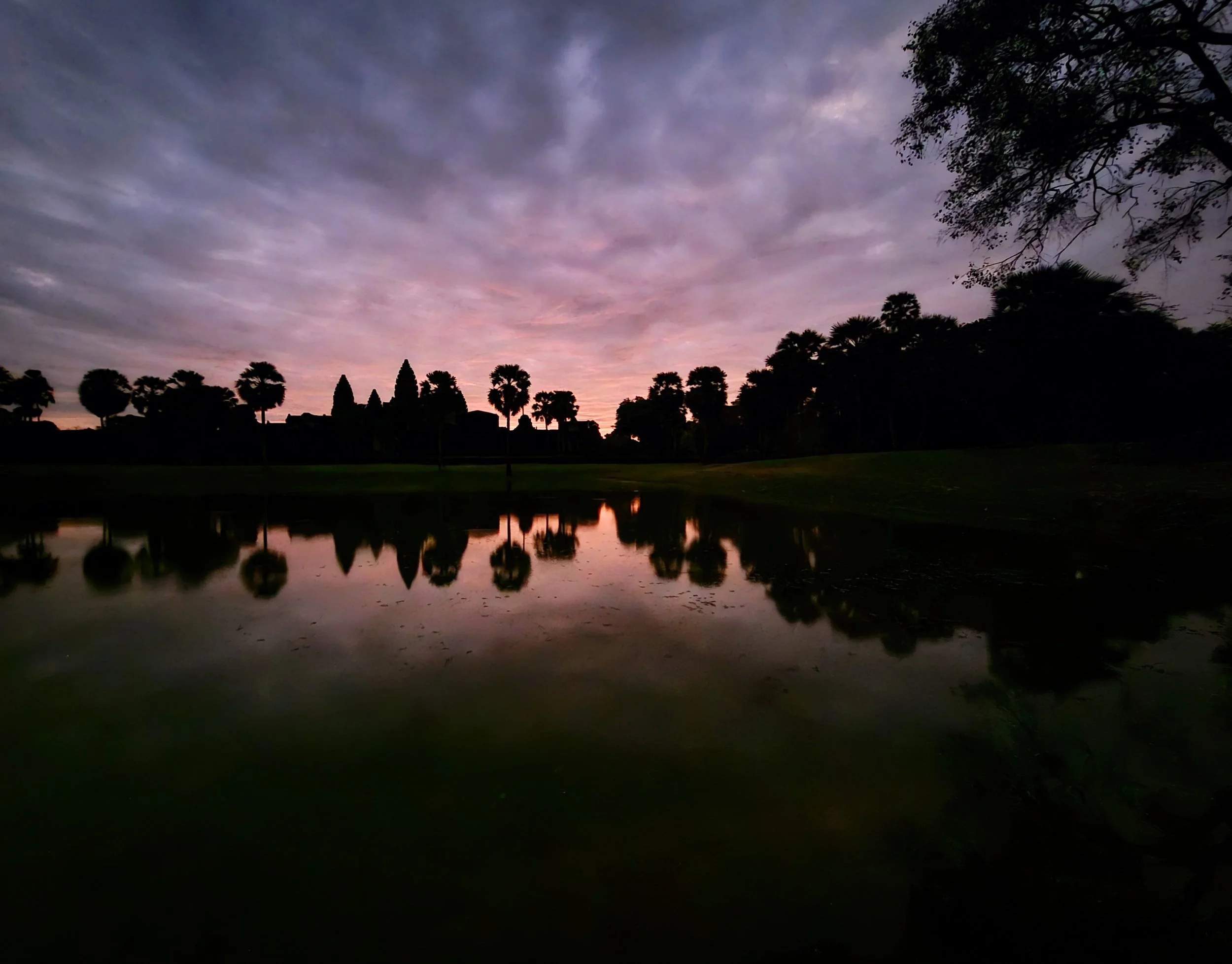
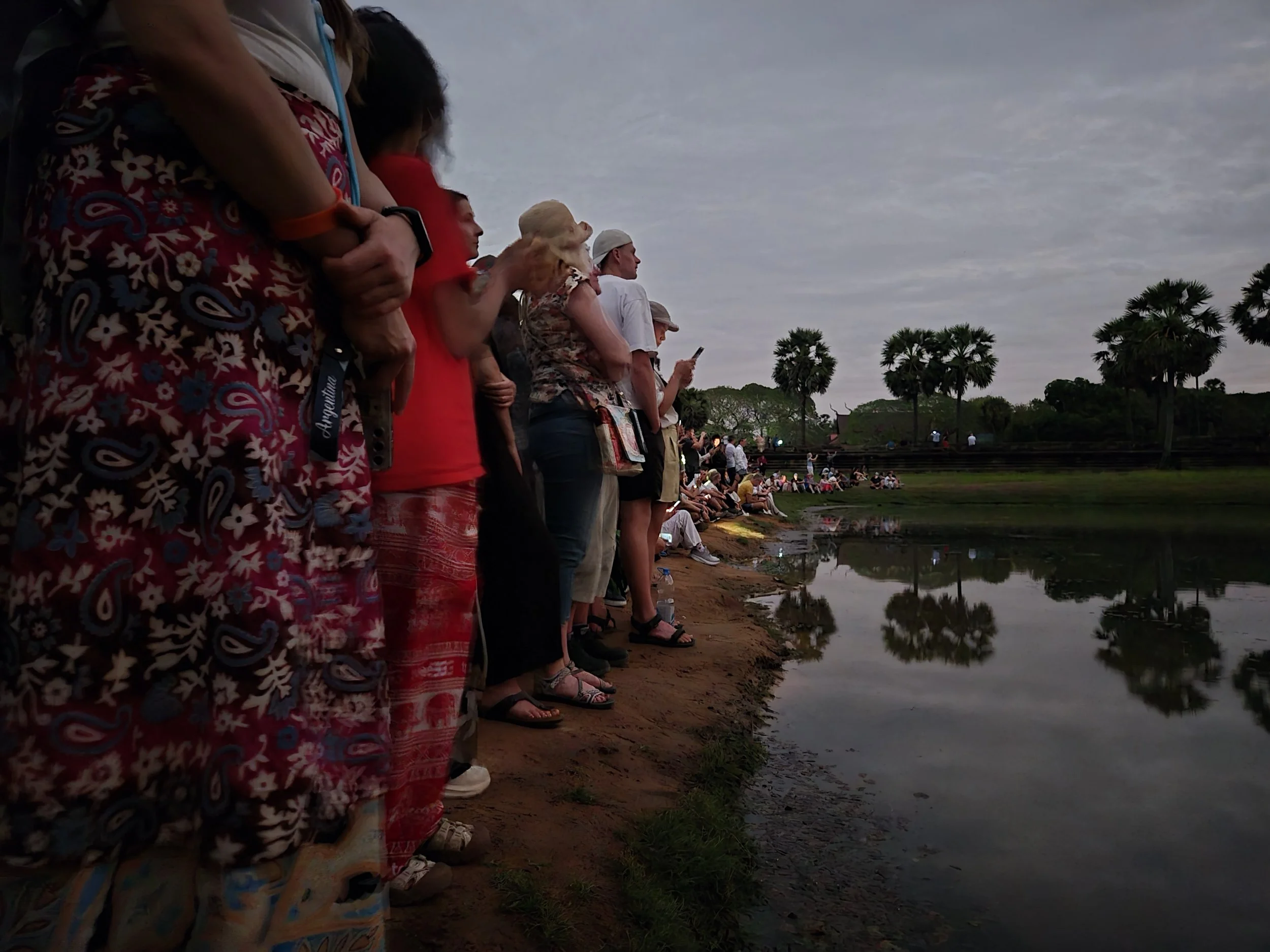

We (my partner and I) walked around the south-east corner and south side of the temple wall and watched the sun rise further while I attempted to get some good shots with only my phone camera (Figure 5-10). While we could have taken the day to just look intricately at the main temple and maybe one another temple nearby, there was a tour group to join and a breakfast to eat before we finally got to enter the sacred space.




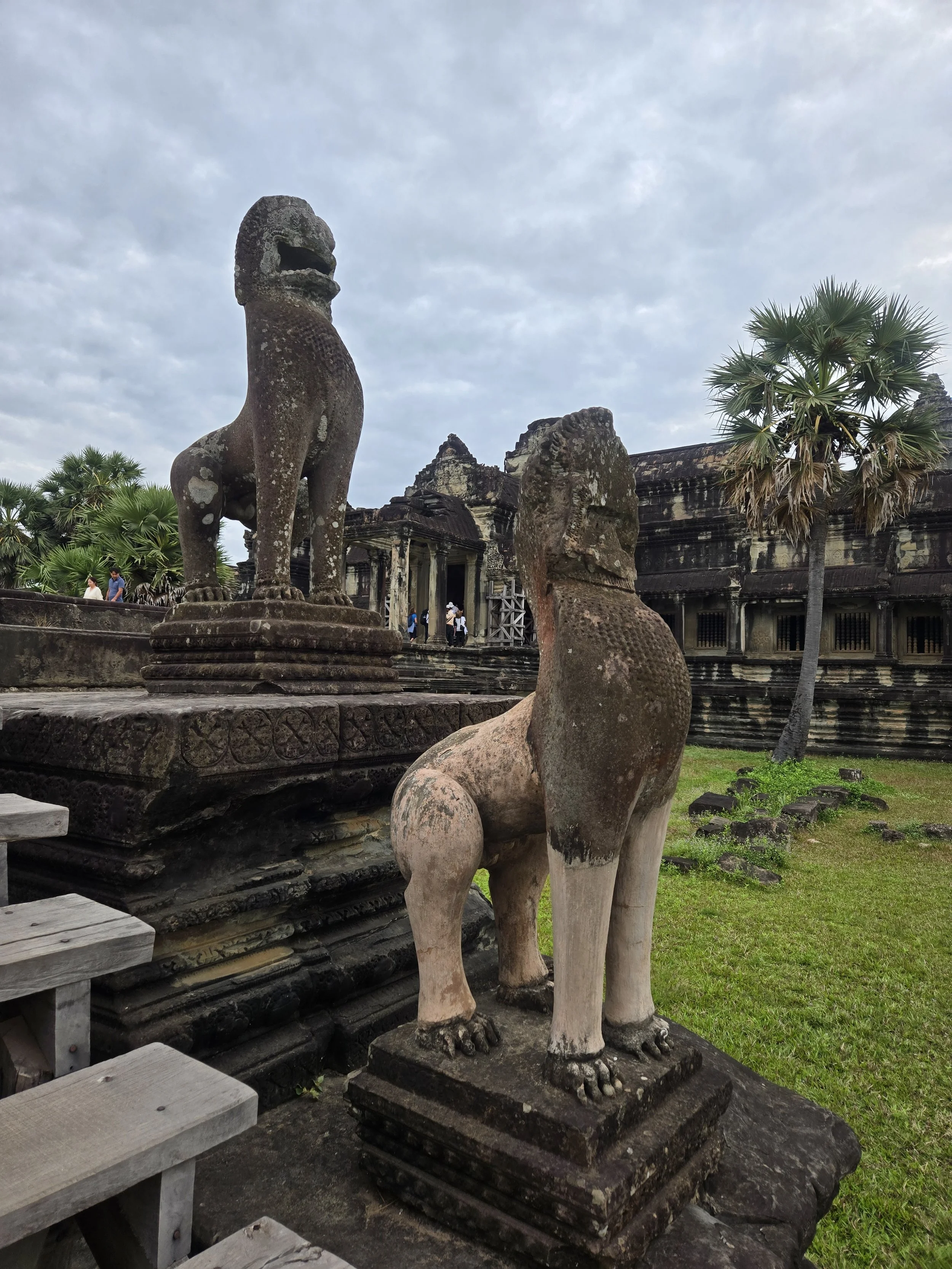

The main building measures 365 meters in length, symbolizing one meter for each day of the year, while Naga, the seven-headed snake god, has a head for each day of the week. The site features five gates in total: three gates depict human figures, and two represent animals, including an elephant gate, as well as gates for horses, cows, and buffaloes. The construction materials are diverse, incorporating wooden houses, sandstone, laterite stone, and volcanic stone. Stones were sourced from a river located 80 to 100 kilometers away and transported via the river itself, using elephants, cows, and buffalo-drawn carts. Here there was estimated to be 3000 elephants at helping to build the temple and another 3000 working at quarry (this is probably an overestimation based in legend). But elephants were the animals ridden by royalty, so I’m not surprised that there were plenty of elephant gates and elevated platforms for the royals to disembark on. Holes were carved into the stones to insert wooden handles, allowing them to be carried or pulled with ropes; some stones weighed up to five tons. Once at the river, the stones traveled on bamboo rafts along canals and moats specially built for this purpose. Around 1,000 laborers were involved in cutting and moving the stones, using dirt ramps to transport them. The main temple was built inside out (reminding me of the Winchester Mystery House) over the centuries, leading to possible architectural inconsistencies when dealing with the flow of sunlight and ritual necessities at specific times of day. Cambodia’s flat terrain, punctuated by a single major mountain and river, made irrigation essential; thus, moats, ponds, and lakes on the site were constructed simultaneously with the palaces and temples to support the complex’s water management system (Figures 11 & 12).
In ancient temple architecture, wooden scaffolding often featured intricate carvings of Naga and Nagin figures—male and female serpent deities or demons—positioned at the corners to guard the stonework as well as the end of staircase handles and their own full statues (Figures 13-15). These protective symbols were believed to shield the hospital or sacred space within, their twining tails artistically entwined to represent unity and balance, while embodying the spiritual guardianship over the structure. Use stone for key stone construction, not metal, because stone lasts longer.
In other temple building within the main Angkor complex, the ancient peoples specifically built 37 steps at the entrance to symbolise the levels of heaven, and they are quite steep, meaning tall and thin (so if you go there, watch your step). The great part is that it is still fairly large up at the top, where one can walk around. Also, because it’s so high up the views are amazing (Figures 16-22).


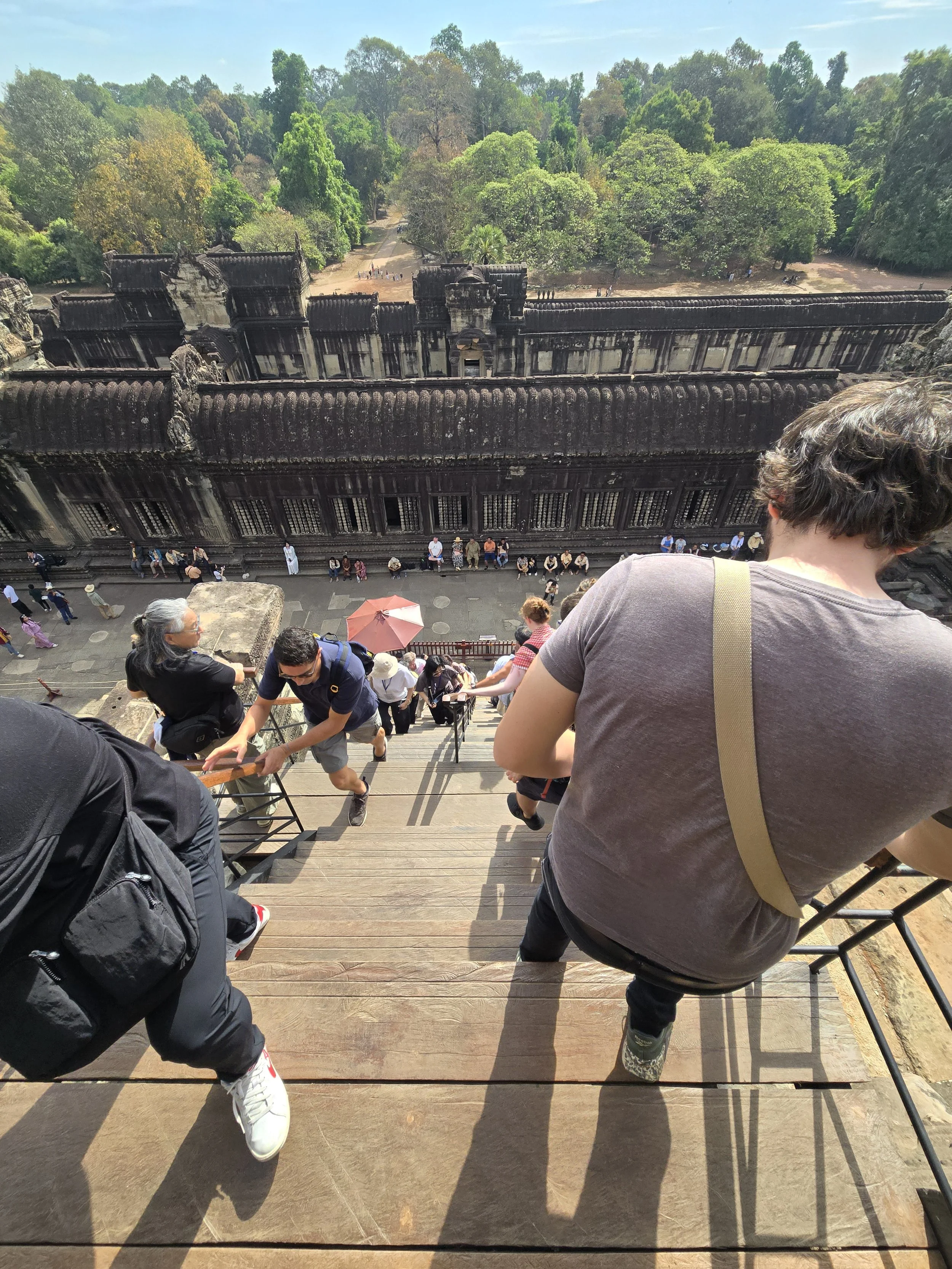


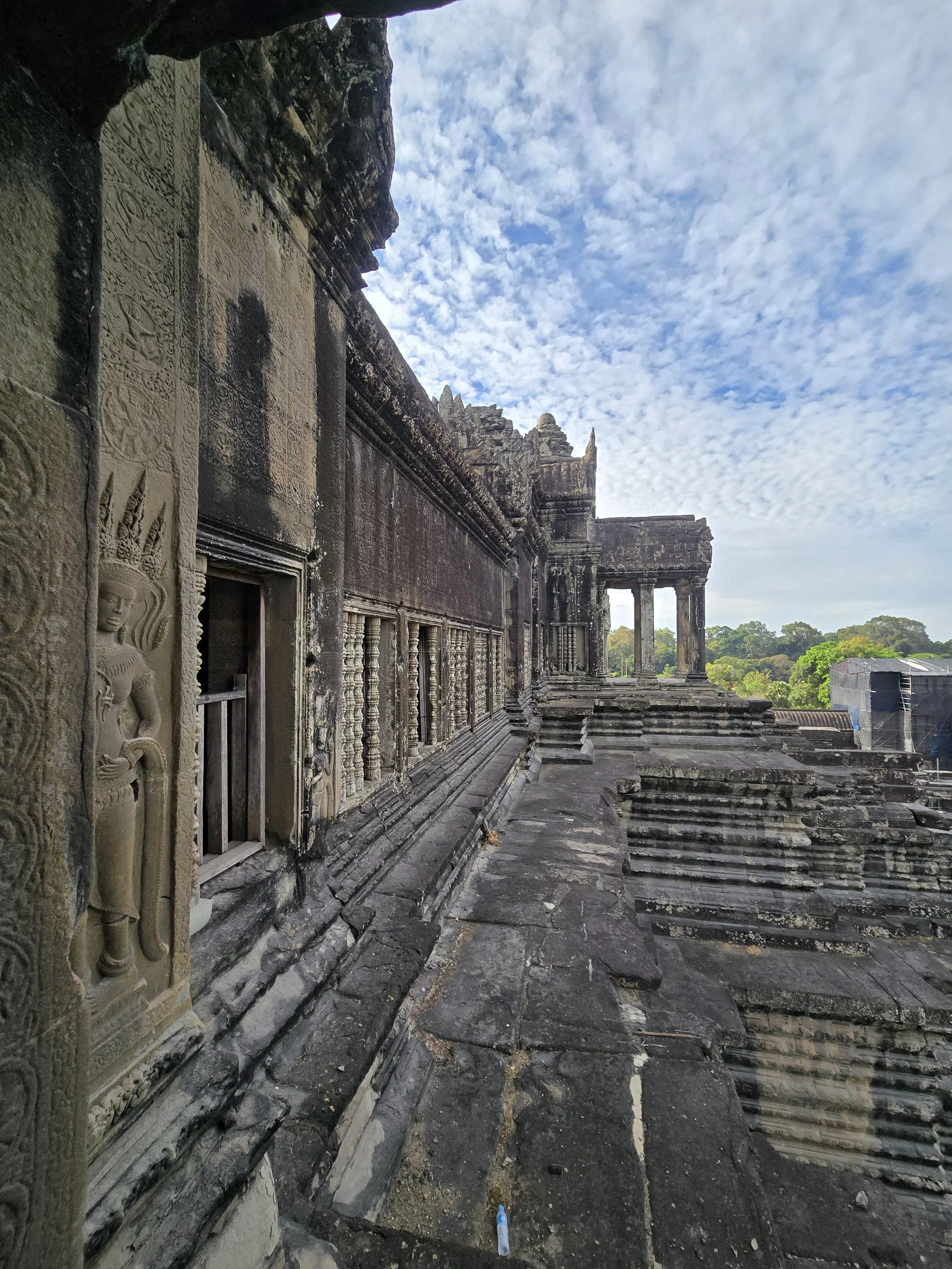

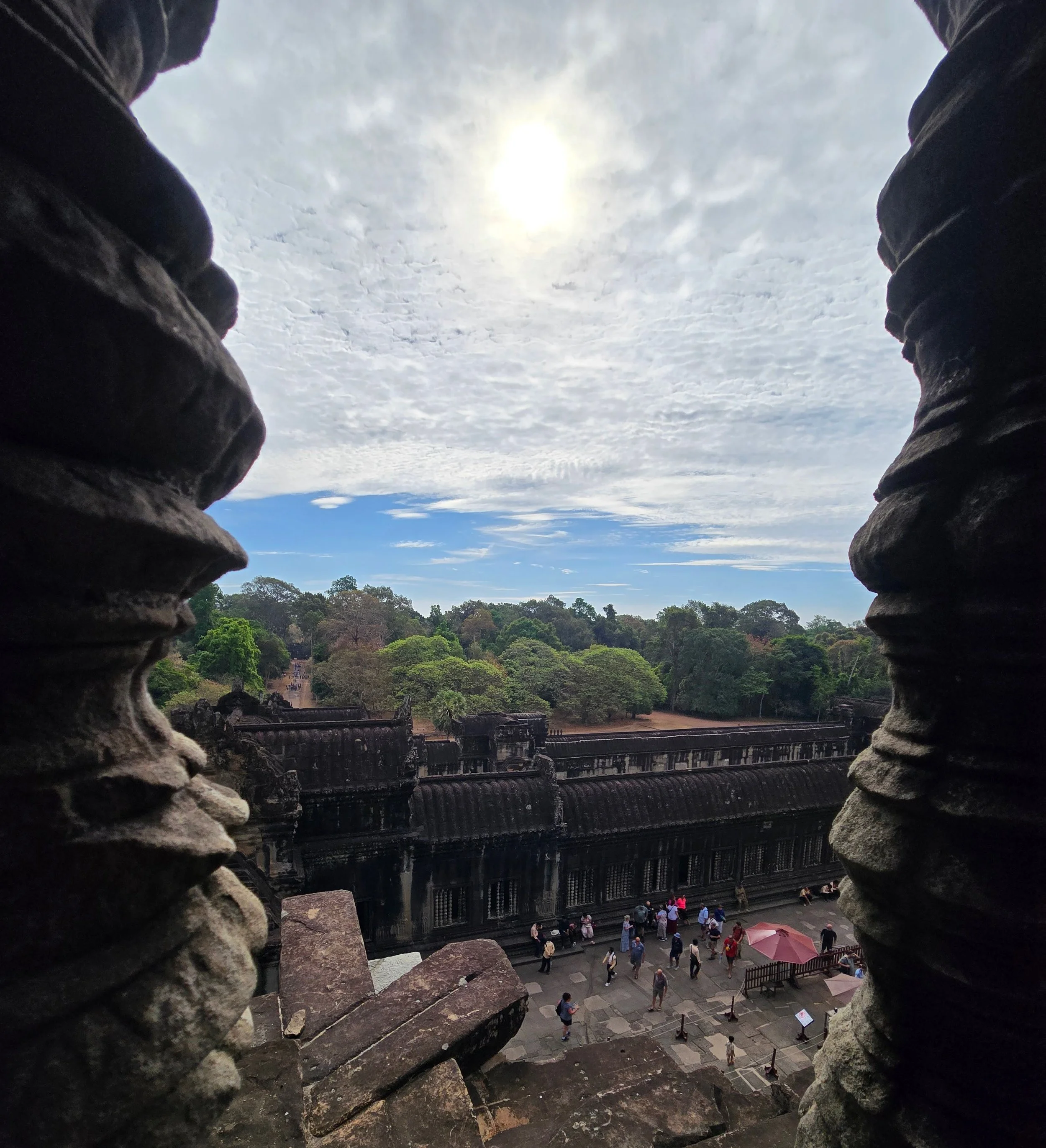
Originally built for Vishu by the Khmer empire in 1150 CE, Angkor Wat (ប្រាសាទអង្គរវត្ត) was built at the behest of the king Suryavarman II in the early 12th century in Yaśodharapura (present-day Angkor), the capital of the Khmer Empire, as his state temple and eventual mausoleum. Over the centuries, new rulers who were Buddhist took control and replaced the statues to follow their beliefs. King after king, dynasty after dynasty, continuously switched between religions. However, it did not destroy any temples; instead, it added new wall text and switched the statues back and forth. Today, the statues still displayed are of the Buddha (Figures 23-26). This place was amazingly multireligious, whether acknowledged or just tolerated (likely the latter), I haven’t heard of a historic example of this since learning about the al-Andalus (the Convivencia) from around 711 to 1492 CE.
<I could tell you much more facts about it, but then I’d basically be reciting the Wiki page (it’s pretty comprehensive actually). So instead I’ll continue sharing more from our guide, of course my own memories.> As you probably noticed there are a ton of inscriptions in the walls and pillars, and no, a lot of it wasn’t carved at the time of building. Whether they are original or new-ish, planned or graffiti, drawing-art or writing, it still can tell an incredible stories, especially the murals with entire battle histories record on them (Figures 27-44). Angkor Wat’s intricate bas-reliefs depict famous Hindu and historical scenes, but some carvings include animals not native to Cambodia, like horses and lions. These details indicate that the Khmer Empire had extensive cultural interactions with distant lands (Bree 2024).
Prayers and stories of historic events and legends are carved on the walls, but there’s interest in the floors too. While I said the walkways outside seemed flowy, a bit uneven, the floors inside the temple were so perfectly placed that they were perfectly level, and even are today (wish I took a picture of the central bubble)(Figure 45).
But there was even more to do with the floors. Seemly purposefully drilling holes, the first figure is an ‘I don’t know’, but the second looks like it could be a game (Figures 46 & 47).
The construction involved moving massive amounts of stone—about 3 million tons and even up to 3 billion tons in total. Each day, workers could extract around 60 tons of stone from the quarry. They would then transport these stones and continue building relentlessly until reaching the top of the structure.
During this process, there was a need to inform people who were responsible for the deceased, possibly to keep them aware of the ongoing work or the path of the ramp used to transport the stones.
The stones used in construction were not initially smooth because of how the rock was quarried. To achieve a smooth surface, artisans selected certain flat stones or used specialized tools to polish the surfaces, creating smooth tables or platforms. This smoothing process was important for religious teachers and kings, who would create drawings or decorations on the stone surfaces as part of their cultural and spiritual practices.
The religious leaders and kings were involved in making carvings and sculptures, possibly while seated on wooden or bamboo chairs. Sculptors worked carefully from top to bottom, because starting from the bottom caused breakage—indicating that the structure or the carving material was more stable when worked on from the top down.
Many sculptures and decorations featured petals, flowers, or floral busts, which were symbolic and decorative motifs. They also made significant progress by building capitals—ornamental tops of columns—around main buildings. This suggests that people didn’t just build temples flat on the ground but raised them with flower motifs to create a towering, mountain-like appearance.
In Hindu belief, mountains are sacred homes or abodes of the gods, and since the area had fewer natural mountains, the king tried to compensate by building tall temple foundations to mimic a mountain’s height. One of the highest temples in the Angkor complex stands as a prime example of this architectural and spiritual ambition.
The Angkor temple complex itself covers an area of about 402 square kilometers, reflecting the massive scale and significance of this ancient cultural site.
There are more than 200 temples around here for one big ticket getting you into the entire site. Angkor Wat, the magnificent temple complex in Cambodia, stands as a powerful symbol of ancient Cambodian history and culture. Originally built in the early 12th century by King Suryavarman II, Angkor Wat was conceived as a Hindu temple dedicated to the god Vishnu. This period marked the height of the Khmer Empire, when Cambodia became one of the largest and most influential kingdoms in Southeast Asia and the world.
By the 12th and 13th centuries, the Khmer Empire had grown mighty, comparable to great empires in history, and Angkor Wat was not only a religious center but also a symbol of political and cultural unity. It reflected the empire’s grand vision, with intricate sculptures and bas-reliefs on the walls depicting Hindu mythology and historical events. Over time, the temple shifted from Hinduism to Buddhism, mirroring the religious evolution of Cambodia itself.
In the late medieval period, around the 14th and 15th centuries, Cambodia experienced various internal conflicts and external pressures, including struggles with neighboring regions such as Siam (modern Thailand) and China. These conflicts shaped the political landscape, but despite these challenges, the cultural and spiritual significance of Angkor Wat endured.
This complex also represents a unification story; originally, Cambodia was divided into provinces and smaller kingdoms, but through periods of strife, they eventually united to form a single nation. This unity echoed the grand vision etched into Angkor Wat’s stone walls.
While we were walking around in front of the carvings the guide told us a story of Preah Ream (Rama), Neang Seda (Sita) his wife, and the enemy Krong Reap (Ravana) who kidnaps her. And is shown in bas-reliefs.
In this legend, Ravana figures as a sort of antagonist, but the drama revolves around the husband's treatment of his wife. The husband tried to make his wife prove her loyalty by asking her to walk through a crown of fire. Despite the challenge, she didn't become upset with her husband.
In the ancient legend of Rama, a tale steeped in devotion, honor, and the eternal struggle between good and evil unfolds.
Preah Ream, a noble prince, lived happily with Sita, known for her loyalty and purity. But a deceitful man tried to take Neang Seda by spreading lies, even reaching the king’s brother, Namcita, and causing family trouble. Despite this, Rama stayed true and loyal, showing that a faithful husband’s love brings happiness and peace to the home.
But darker forces moved in the shadows. Ravana, the demon king, driven by greed and cruelty, kidnapped Sita, ripping her from the safety of Rama’s care and plunging the land into chaos. Ravana’s treachery was a grave sin against sacred bonds of love and loyalty. The legend holds a stern warning: those who steal what is not theirs and violate divine trust will suffer the consequences of justice.
With unmatched strength, wisdom, and courage, the monkey general and devoted ally of Preah Ream, Hanuman, led an army of monkeys and bears across vast forests and mountains to the demon king’s fortress. His was able to locate Neang Seda, keeping hope alive in the face of despair.
In the climactic battle, Rama came face to face with Ravana. With moral righteousness and the aid of his faithful companions, he defeated the demon king, restoring order and virtue to the world. But, before reuniting fully with Rama, Sita had to face the ultimate trial: the fire ordeal. Walking through flames untouched, she proved her purity and unwavering loyalty, a testament to the power of righteous deeds and divine protection. The gods and guardians descended from the heavens to shield the Earth, affirming that good action calls forth heavenly guardianship even in the direst moments.
But in a poignant and unexpected turn, Sita, after emerging unscathed, chose to bid farewell to her husband. She implied that a bad husband, no matter how noble, could no longer hold her heart. This bittersweet ending reminds us that fidelity flows both ways, and true love flourishes only where respect and virtue are upheld by both partners.
The legend of Rama and Sita teaches loyalty, justice, and love’s sacredness—divine forces protect the righteous, and courage overcomes evil. The clear lesson: men must treat their wives with respect and kindness or risk losing them.
The wooden sculptures were originally painted with a golden color, but after about 400 years—or possibly by the third century—the golden paint began to fade and disappear. During this period, as cultural practices shifted from Hindu traditions toward Buddhist influences, artists started using red paint instead. Evidence shows that red pigments were applied around the 1600s. (Figure
Over roughly 750 years, the original colors have mostly faded, especially the gold. At the base of some of these artifacts, there is a signature or marking attributed to a historical figure. This detail helps us understand the timeline and cultural changes reflected in the art. While the golden color has largely vanished, the red pigments from the later period remain visible, showing a fascinating evolution of color usage linked to shifting religious and cultural contexts.
Between the multiple squares of temple spires, there are square holes that were once filled with water, ‘where this became the hospital. You can see that the floors of the building get floppy. After the flooding, the water could have flowed down to the man-made ponds. The water in the inside baths could have been different colors depending on what it was treated with. It was the natural temperature when in any of the square ponds, but often boiled for medicinal purposes. Back in the day, there were no modern doctors around, so people relied on natural remedies. They built treatments based on the four elements—earth, water, air, and fire. When you go to collect water from a pond and boil it, it sometimes becomes an effective medicine, though other times it doesn’t work. Nearby, you can find ancient writings, including records by a king from Hindu to Boris, who documented many opportunities and practices around this area. These writings helped preserve knowledge and guided people in their use of natural resources for healing’ (Figures - & -)(Guide at Angkor Wat 2025).
When we went to the Lara Croft made-famous temple Ta Prohm was the first time I’d even seen those buildings (cause there are many more than one) and jambu (Syzygium jambos) trees (strangler figs/ silk-cotton trees). While they are incredible beautiful and add an air of mystery about the temples, we have to remember, they weren’t meant to be there.
While visiting there was active work going on in which workers were carefully cutting down the trees so they wouldn’t further destroy the temples. Because, yes growing through temple walls in very bad for building stability. For images with the trees intact (Figures - - -).
The Bayon Temple was built in the late 12th or early 13th century as the official state temple of the Mahayana Buddhist King Jayavarman VII (ព្រះបាទជ័យវរ្ម័នទី ៧) standing at the centre of Jayavarman's capital, Angkor Thom (អង្គរធំ). Following Jayavarman's death, it was modified and augmented by later Hindu and the ravada Buddhist kings in accordance with their own religious preferences.
The Bayon’s hallmark is the many serene, smiling stone faces on towers around its central peak. It features unique bas-reliefs blending mythological, historical, and everyday scenes. The Japanese Government Team for the Safeguarding of Angkor calls it "the most striking expression of the baroque style" in Khmer architecture, as contrasted with the classical style of Angkor Wat (Angkor Enterprise n.d.). Of course of the most controversial or question making carving of (probably) the entire complex are the creatures within the swirl carvings. They contain mythological creatures from Hinduism or Buddhism and some people like to say that the 3rd creature down in the first figure below is a stegosaurus… While that does sound interesting, I don’t think it’s accurate because all of the circles have backgrounds and if the bumps were the spikes then it wouldn’t. So it’s more likely a bush or some other decoration. Other people have said that it could be a modern hoax, done before it was noticed in 1997, but the relief matches perfect with the other stones above and below and is on the same stone as the next relief lower down. Also whether we actually recognize it or not from real life doesn’t matter because it may be mythological, especially since it looks like all of the creatures in that multiple series could easily be as well.
Located in northern Cambodia’s Siem Reap province, Angkor is a key Southeast Asian archaeological site. It features temples, hydraulic structures (basins, dykes, reservoirs, canals), and communication routes spanning 400 sq km of evolving urban planning. Temples in the area include, but are not limited to, Angkor Wat, Bayon, Preah Khan, and Ta Prohm, reflecting Khmer architectural links demonstrated in the site’s design, showing a complex social hierarchy and highlighting cultural, religious, and artistic significance. Communities still inhabit the park, with many tracing their ancestry to the Angkor era, who primarily farm rice.
The Angkor site is an official UNESCO World Heritage Site and has been so since 1992. Archaeologists, historians, architects, and more specialists on the UNESCO advisory board came together to evaluate the site based on a specific set of criteria, which are used to evaluate any potential historic or prehistoric site to determine whether it has “integrity” and should thus be protected. According to the UNESCO website, the following was the board’s final evaluation for the Angkor complex for each criterion:
Criterion (i): The Angkor complex represents the entire range of Khmer art from the 9th to the 14th centuries, and includes a number of indisputable artistic masterpieces (e.g. Angkor Wat, the Bayon, Banteay Srei).
Criterion (ii): The influence of Khmer art as developed at Angkor was a profound one over much of South-east Asia and played a fundamental role in its distinctive evolution.
Criterion (iii): The Khmer Empire of the 9th-14th centuries encompassed much of South-east Asia and played a formative role in the political and cultural development of the region. All that remains of that civilization is its rich heritage of cult structures in brick and stone.
Criterion (iv): Khmer architecture evolved largely from that of the Indian sub-continent, from which it soon became clearly distinct as it developed its own special characteristics, some independently evolved and others acquired from neighboring cultural traditions. The result was a new artistic horizon in oriental art and architecture.
Integrity
The Angkor complex encompasses all major architectural buildings and hydrological engineering systems from the Khmer period and most of these “barays” and canals still exist today. All the individual aspects illustrate the intactness of the site very much reflecting the splendor of the cities that once were. The site integrity however, is put under dual pressures:
1. endogenous: exerted by more than 100,000 inhabitants distributed over 112 historic settlements scattered over the site, who constantly try to expand their dwelling areas;
2. exogenous: related to the proximity of the town of Siem Reap, the seat of the province and a tourism hub.
Authenticity
Previous conservation and restoration works at Angkor between 1907 and 1992, especially by the École Française d’Extrême-Orient (EFEO), the Archaeological Survey of India, the Polish conservation body PKZ, and the World Monuments Fund have had no significant impact on the overall authenticity of the monuments that make up the Angkor complex and do not obtrude upon the overall impression gained from individual monuments.
(UNESCO World Heritage Centre, n.d.)
Citations:
Angkor Enterprise. n.d. Temple Bayon. https://www.angkorenterprise.gov.kh/temple/81/bayon.
Bree. 27 Sep 2024. Hidden Wonders of Angkor Wat: Unique Facts You May Not Know. SecretRetreats Blog. https://www.secret-retreats.com/blog/travel/hidden-wonders-of-angkor-wat-unique-facts-you-may-not-know.html#:~:text=While%20Angkor%20Wat%20is%20now%20a%20Buddhist,testament%20to%20its%20long%20and%20diverse%20history.
UNESCO World Heritage Centre. (n.d.). Angkor. https://whc.unesco.org/en/list/668/#:~:text=Angkor%2C%20in%20Cambodia's%20northern%20province,and%20more%20specifically%20rice%20cultivation. Description is available under license CC-BY-SA IGO 3.0.












































































